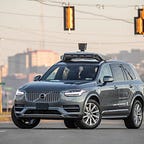Our Public Safety Officials and First Responders’ Guide
By Mark Jones and Wade Stormer, Law Enforcement Operations, Uber
At Uber ATG, we recognize that to continue the safe development of self-driving vehicles, it is essential that we be transparent with the public and other stakeholders about our approach. Through proactive information-sharing and ongoing two-way dialogue that takes external views into account, we can both educate and learn from our stakeholders and others in the self-driving community.
Working with public safety officials and first responders is an important part of how we connect with the communities in which we operate. Our engagement strategy uses a multi-channel communications approach to ensure broad and easy access to the latest relevant information on our operations. This combined with community activities such as in-person briefings, town hall events, and publicly available materials fosters a consultative dialogue. Just as our development and testing activities will iterate over time, our approach in collaborating with public safety officials and first responders will also mature. The results of this will be new and updated guides and tools that aim to keep key stakeholders informed as our technology and operations evolve.
Today we are releasing our Public Safety Officials and First Responders’ Guide. The purpose of this guide is to provide information to trained public safety officials and first responders on how to safely interact with an Uber ATG developmental self-driving vehicle (SDV) in the event of an emergency. This guide applies specifically to on-road Uber ATG developmental vehicles with a highly trained Mission Specialist behind the wheel. Mission Specialists are trained safety drivers who have undergone internal certification and specialized training that prepares them for a wide range of scenarios and incidents, from manually-directed traffic and routine traffic stops to incidents where a first responder has been called.
We will release additional guides as our operations continue to develop, such as for driverless testing, or for new vehicle platforms. This guide does not apply to third-party self-driving vehicles that may operate on the Uber network in the future.
What’s Inside the Guide?
- Identifying an Uber ATG Vehicle: From the top-mounted lidar to the side branding, understand everything that comprises a developmental self-driving vehicle.
- Post-Crash Safety Features: The Volvo XC90 base vehicle post-impact safety features are enabled and expected to function as designed, depending on the type and severity of collision detected.
- Disengagement, Immobilization, and Powering Down: In the event of an incident, Mission Specialists follow protocols for disengaging, immobilizing, and powering down the self-driving system.
- Vehicle Extrication and Post-Incident Response: After an incident, safety protocols for vehicle extrication, relocation, and towing should be followed.
Additionally, for law enforcement personnel, there is a step-by-step process for submitting post-incident data requests to the Uber Law Enforcement Response Team (LERT) through their portal at lert.uber.com.
In keeping with our goal of transparency and two-way dialogue, Uber ATG is committed to continued engagement with public safety officials and first responders. We hope to provide additional information-sharing opportunities in the form of in-person briefings and other events to demonstrate how we keep safety at the forefront of self-driving vehicle development and testing. For more information on safety at Uber ATG, you can visit our Safety website, and for more information on our approach to city road testing, visit our Cities website.
